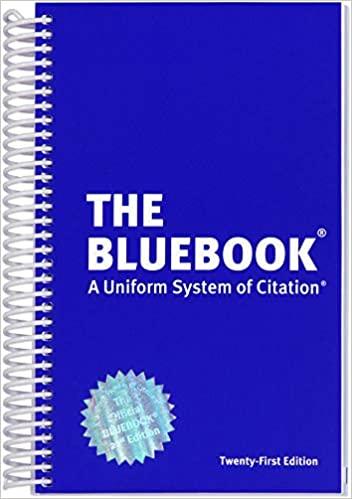1. The CED is: (a) A legal resource that is only available on Quicklaw (b) A loose-leaf multi-volume legal encyclopedia that provides a very general
1. The CED is: (a) A legal resource that is only available on Quicklaw (b) A loose-leaf multi-volume legal encyclopedia that provides a very general overview of most areas of law (c) known as the "Canadian Encyclopedia Addendum"
2. A reported case: a) Can only be found in Quicklaw or Westlaw b) Is a judge's decision and reasons about a case published in a law report series c) Is a case not published in a law report series d) All the above e) None of the above
3. A Boolean Search is: a) A technique used exclusively on CanLII to find caselaw b) A method by which the computer hunts through thousands of documents to locate requested combinations of words or phrases c) Helps a researcher figure out key words to use in a search for caselaw d) All the above e) None of the above
4. Ratio Decidendi means: a) It has been decided b) Reasons for deciding c) Let the buyer beware d) None of the above
5. When dealing with Sources of Canadian Law, it is made up of: a) Statutes b) Regulations c) Decisions/Caselaw d) All the above e) None of the above
6. A decision of the Superior Court of Justice: a) Is binding on all other provincial courts b) Is not binding on the Small Claims Court c) may be considered binding on the inferior provincial court d) is binding on its own 7. A statute passed by either federal Parliament or provincial legislatures: (a) Can be used as a source of law (b) Cannot be used as a source of law in an administrative body (c) Is categorized exclusively as private law (d) All the above (e) None of the above
8. Binding law is: (a) law that must be followed by a court (b) law that a court is not required to follow (c) law that should be followed by a court (d) law that a court is not required to follow, but may follow if it wishes
9. In a case on appeal where there is a majority opinion and a dissent, only the: (a) Minority ratio is binding (b) Dissenting decision matters (c) Majority ratio is binding (d) Persuasive value of the decision matters
10. The main purpose of legal research is: (a) To determine what secondary sources are used to argue the law (b) To find binding law that is relevant to a legal problem you need to solve (c) To exclusively understand a Regulation
11. When reading caselaw, a headnote is the judge's explanation or summary of the case. (a) True (b) False
12. Orbiter Dicta is binding. (a) True (b) False
13. A decision of the Provincial Court of a province is not binding on, but is persuasive to, other judges of the Provincial Court. (a) True (b) False
14. Regulations can come into force upon "filing", "registration", or "publication". (a) True (b) False
15. A style of cause contains the name of the law report series. (a) True (b) False 16. When you quote a statute for research, never paraphrase. Quote the statute exactly or you'll change its meaning. (a) True (b) False
17. A parallel citation tells you about other reports where the same case report can be found. (a) True (b) False
18. A disposition is the judge's orders set out at the end of a case. (a) True (b) False
19. A Provincial Court of Appeal binds every court in that province. (a) True (b) False
20. Persuasive law is law that must be followed by a court. (a) True (b) False
Step by Step Solution
There are 3 Steps involved in it
Step: 1

See step-by-step solutions with expert insights and AI powered tools for academic success
Step: 2

Step: 3

Ace Your Homework with AI
Get the answers you need in no time with our AI-driven, step-by-step assistance
Get Started


